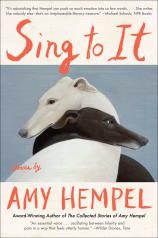Sing to It: New Stories
Review
Sing to It: New Stories
It’s been 14 years since the publication of Amy Hempel’s last volume of new short fiction, THE DOG OF THE MARRIAGE. As a result, SING TO IT, her latest collection, is likely to feel as refreshing to fans of her distinctive stories as a desert oasis. Unfortunately, for all of Hempel’s skill as an accomplished literary miniaturist, with the exception of the compelling novella that makes up nearly half the book, there’s barely enough material here to whet the appetite of newcomers to her work.
The novella “Cloudland,” which concludes SING TO IT, is a vivid demonstration of Hempel’s considerable talent when she opens out of the confines of her haiku-like stories. Its unnamed narrator is a former English teacher at a Manhattan private school for girls, who has moved to an unglamorous section of northern Florida after the indiscretion that caused her to lose a job she held for 20 years. She now works part-time as a home health aide for mostly elderly patients. Her seemingly unremarkable life is haunted by the memory of the child she gave birth to and then gave up at a maternity home in Maine as an 18-year-old unwed mother. “The transaction was not free, but I was free to go,” she recalls in describing the event and its aftermath.
"The novella 'Cloudland,' which concludes SING TO IT, is a vivid demonstration of Hempel’s considerable talent when she opens out of the confines of her haiku-like stories."
The story proceeds along parallel tracks. In one, the narrator gradually reveals the horror that surrounds the circumstances of her daughter’s birth (its dreadful facts based on a true story mentioned in the book’s acknowledgements). In the other, she plumbs the utter strangeness of her present-day existence, in a world where vegetation and wildlife flourish unchecked, like the roof ferns that are “growing from the inside out, spreading in what looks like time-lapse photography.”
Hers is an existence that features visits to psychics, the leering attention of an intrusive elderly neighbor and sexual abuse elsewhere in the neighborhood. Through all this, the narrator dashes off razor-sharp and emotionally resonant observations about everything from climate change to the lingering ache when she imagines the life of the daughter she abandoned. “I’d say I’m getting better here,” she observes, “but that might be premature. I am not getting worse is what I should probably say.”
But for all the allure of this unsettling, unforgettable story, it stands out in part because of its stark contrast to the remainder of the book. The brevity of the remaining 14 stories in this slim volume --- 10 of them two pages or fewer and another barely three pages --- render the term “minimalist” that’s often been attached to Hempel wildly insufficient. Next to her, Raymond Carver feels like Leo Tolstoy. Most of the stories feel like sketches for more substantial works, or candidates for the title of flash fiction.
To be sure, Hempel is a gifted writer whose prose often is evocative, memorable and mordantly humorous. In the title story, a dying man demands “No metaphors!” of a loved one or caregiver. The story’s final two paragraphs hit with true force: “So --- at the end, I made my hands a hammock for him. My arms the trees.” In a single page, “The Orphan Lamb” shifts seamlessly from a description of the graphic skinning of a dead lamb, in which “brutality saves a life,” to a tender moment of seduction. The Narrator of “The Quiet Car” is reminded of the time she “knew a romance was over,” when a man she hadn’t seen in a while invited her to “take the Acela somewhere” with him, only to suggest they sit in the eponymous car, an example of Hempel’s dry wit.
But “The Second Seating” is nothing more than a three-paragraph account of three friends meeting for dinner at a resort to mark the passing of a mutual friend. “Equivalent” describes an odd relationship between the buyer of a problem-plagued home and the seller who periodically “arrived unannounced to pick up something he had left behind.” Stories like these are suggestive, but beg for the nuance and depth a skilled writer like Hempel is capable of providing. Too often it feels as if a skilled painter is asking the observer to fill in a work with material from outside the frame. In short, there’s much to admire in SING TO IT, but from a writer as good as Amy Hempel, one wishes there was more to love.
Reviewed by Harvey Freedenberg on March 29, 2019
Sing to It: New Stories
- Publication Date: November 12, 2019
- Genres: Fiction, Short Stories
- Paperback: 160 pages
- Publisher: Scribner
- ISBN-10: 1982109122
- ISBN-13: 9781982109127




